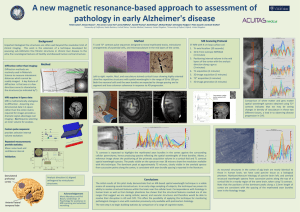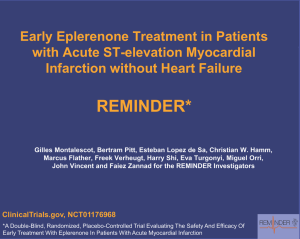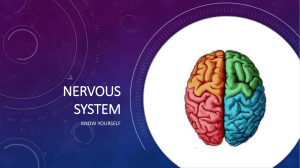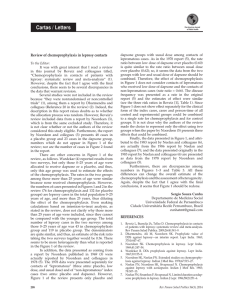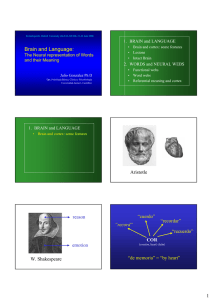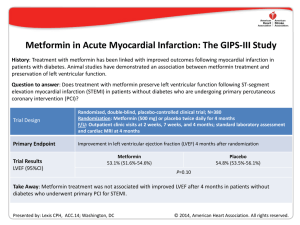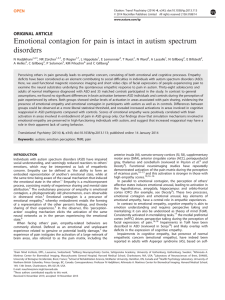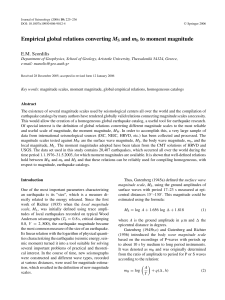Komulainen et al 2021 - Escitalopram enhances synchrony of brain responses during emotional narratives in patiens with MDD
Anuncio
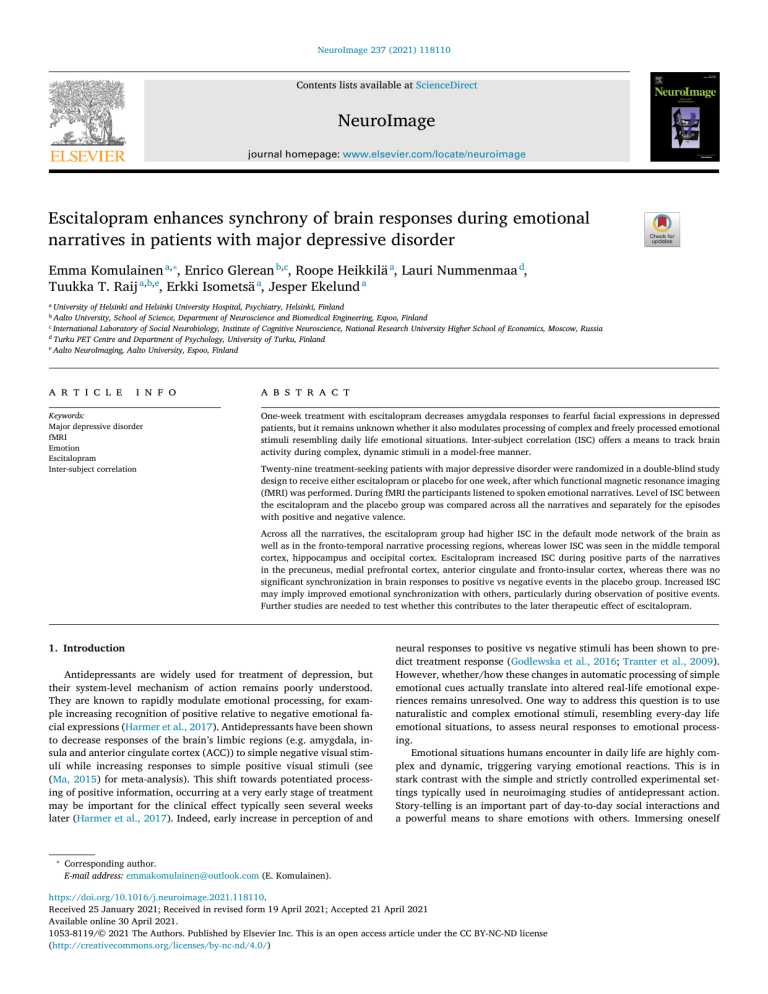
NeuroImage 237 (2021) 118110 Contents lists available at ScienceDirect NeuroImage journal homepage: www.elsevier.com/locate/neuroimage Escitalopram enhances synchrony of brain responses during emotional narratives in patients with major depressive disorder Emma Komulainen a,∗, Enrico Glerean b,c, Roope Heikkilä a, Lauri Nummenmaa d, Tuukka T. Raij a,b,e, Erkki Isometsä a, Jesper Ekelund a a University of Helsinki and Helsinki University Hospital, Psychiatry, Helsinki, Finland Aalto University, School of Science, Department of Neuroscience and Biomedical Engineering, Espoo, Finland c International Laboratory of Social Neurobiology, Institute of Cognitive Neuroscience, National Research University Higher School of Economics, Moscow, Russia d Turku PET Centre and Department of Psychology, University of Turku, Finland e Aalto NeuroImaging, Aalto University, Espoo, Finland b a r t i c l e i n f o Keywords: Major depressive disorder fMRI Emotion Escitalopram Inter-subject correlation a b s t r a c t One-week treatment with escitalopram decreases amygdala responses to fearful facial expressions in depressed patients, but it remains unknown whether it also modulates processing of complex and freely processed emotional stimuli resembling daily life emotional situations. Inter-subject correlation (ISC) offers a means to track brain activity during complex, dynamic stimuli in a model-free manner. Twenty-nine treatment-seeking patients with major depressive disorder were randomized in a double-blind study design to receive either escitalopram or placebo for one week, after which functional magnetic resonance imaging (fMRI) was performed. During fMRI the participants listened to spoken emotional narratives. Level of ISC between the escitalopram and the placebo group was compared across all the narratives and separately for the episodes with positive and negative valence. Across all the narratives, the escitalopram group had higher ISC in the default mode network of the brain as well as in the fronto-temporal narrative processing regions, whereas lower ISC was seen in the middle temporal cortex, hippocampus and occipital cortex. Escitalopram increased ISC during positive parts of the narratives in the precuneus, medial prefrontal cortex, anterior cingulate and fronto-insular cortex, whereas there was no significant synchronization in brain responses to positive vs negative events in the placebo group. Increased ISC may imply improved emotional synchronization with others, particularly during observation of positive events. Further studies are needed to test whether this contributes to the later therapeutic effect of escitalopram. 1. Introduction Antidepressants are widely used for treatment of depression, but their system-level mechanism of action remains poorly understood. They are known to rapidly modulate emotional processing, for example increasing recognition of positive relative to negative emotional facial expressions (Harmer et al., 2017). Antidepressants have been shown to decrease responses of the brain’s limbic regions (e.g. amygdala, insula and anterior cingulate cortex (ACC)) to simple negative visual stimuli while increasing responses to simple positive visual stimuli (see (Ma, 2015) for meta-analysis). This shift towards potentiated processing of positive information, occurring at a very early stage of treatment may be important for the clinical effect typically seen several weeks later (Harmer et al., 2017). Indeed, early increase in perception of and ∗ neural responses to positive vs negative stimuli has been shown to predict treatment response (Godlewska et al., 2016; Tranter et al., 2009). However, whether/how these changes in automatic processing of simple emotional cues actually translate into altered real-life emotional experiences remains unresolved. One way to address this question is to use naturalistic and complex emotional stimuli, resembling every-day life emotional situations, to assess neural responses to emotional processing. Emotional situations humans encounter in daily life are highly complex and dynamic, triggering varying emotional reactions. This is in stark contrast with the simple and strictly controlled experimental settings typically used in neuroimaging studies of antidepressant action. Story-telling is an important part of day-to-day social interactions and a powerful means to share emotions with others. Immersing oneself Corresponding author. E-mail address: [email protected] (E. Komulainen). https://doi.org/10.1016/j.neuroimage.2021.118110. Received 25 January 2021; Received in revised form 19 April 2021; Accepted 21 April 2021 Available online 30 April 2021. 1053-8119/© 2021 The Authors. Published by Elsevier Inc. This is an open access article under the CC BY-NC-ND license (http://creativecommons.org/licenses/by-nc-nd/4.0/) E. Komulainen, E. Glerean, R. Heikkilä et al. NeuroImage 237 (2021) 118110 in stories during social interaction or listening to a radio program or watching a movie evokes strong emotional reactions and experiences. These time-variable reactions to emotional stories can be tracked and used to model brain responses to dynamically varying affective states (Nummenmaa et al., 2014a). Listening to emotional stories activates the core emotional circuits of the brain in a similar way as during simple, controlled visual stimuli (Ferstl et al., 2005; Wallentin et al., 2011). However, working with uncontrolled daily life -like stimuli poses methodological challenges and requires different approaches than the ubiquitous mass-univariate general linear model (GLM) fMRI analysis. To overcome the difficulty in creating a valid stimulus model, intersubject correlation (ISC) analysis offers a means to track neural activation during complex, dynamic stimuli by using the activity of one brain to predict activity of another brain (Hasson et al., 2004). It has been shown that ISC is comparable to GLM in controlled research paradigms (Pajula et al., 2012) and to date, ISC has been successfully adopted to study multiple cognitive processes during complex stimuli, both in healthy as well as clinical populations (for a review see (Nummenmaa et al., 2018)). Interestingly, the degree of synchrony in neural responses during listening to emotional narratives or watching an emotional movie clip in healthy volunteers depends on the intensity of their varying affective state evoked by the stimulus (Nummenmaa et al., 2012; Nummenmaa et al., 2014a). This increased synchrony of brain responses during observation of emotional events may help to mentalize others’ emotions and thus understand their mental state and intentions (Nummenmaa et al., 2012). Depressed patients have been reported to have decreased synchrony compared with healthy controls in sensory and emotional regions of the brain (Guo et al., 2015). In the current study we sought to investigate whether/how a oneweek treatment with escitalopram modulates brain activity of treatment seeking depressed patients in response to spoken, emotional narratives. Escitalopram is a selective serotonin reuptake inhibitor (SSRI) which potentiates serotonin transmission by blocking serotonin reuptake into presynaptic serotonergic neurons (Harmer et al., 2017). SSRIs are usually first-line medications used for major depressive disorder (Bauer et al., 2007). We assessed the effects of escitalopram on emotional processing at the early stage of the treatment, before any effect on depressive symptoms is expected, to avoid the confounding effect of improved mood. We compared the level of ISC between the escitalopram and the placebo group to identify changes in brain activity due to antidepressant treatment. Furthermore, we repeated the analysis separately for positive and negative emotional stories to identify the effect of the emotional content in the level of escitalopram modulated ISC. ble somatic illness, depression due to somatic illness or substance use, life-time alcohol or drug dependence, alcohol or drug abuse during the last 12 months, current use of illicit drugs (cannabis during last three months, other drugs during last month), excessive consumption of alcohol (>24 U/week for men and >16 U/week for women), current use of an antipsychotic agent, mood stabilizer, systemic corticosteroid, beta blockers, or benzodiazepine, or a contraindication for magnetic resonance imaging (MRI). The study was investigator-initiated, double-blind, randomized and placebo-controlled. The study was approved by the Ethics Committee of Helsinki and Uusimaa Hospital District and each participant provided a written informed consent. The subjects were randomized to receive either placebo or escitalopram 10 mg daily for one week (+/- one day was allowed). After this (at day 7), functional magnetic resonance imaging (fMRI) was performed. Three subjects discontinued participation during the first week, one subject’s fMRI failed due to anxiety in the scanner, two subjects’ fMRI run ended before completion, and two subjects had to be excluded due to excessive head movement during fMRI. Thus, 29 subjects (n = 15 for escitalopram group, n = 14 for placebo group) were included in the final study sample. Comorbid anxiety disorders were detected in the SCID for 15 patients (6 in the drug group, 9 in the placebo group) with no significant differences between the groups (p = 0.272 in Fisher’s exact test). 2. Materials and methods During fMRI the subjects listened to emotional narratives, spoken with neutral female voice, with no prosodic cues about the emotional content. The narratives were 45 seconds long each and included 10 pleasant, 10 unpleasant and 10 neutral stories. The subjects were instructed to listen to the narratives and imagine the events of the stories vividly, trying to become immersed in the stories. The stories were preceded by a 5 s fixation cross and a 15 s short text describing the general setting of the upcoming story. The 15 s text also served as a washout period for the evoked emotions, before the next story. The stimuli were presented using Presentation software (Neurobehavioral Systems Inc., Albany, CA, USA). The narratives were played to the subjects with an UNIDES ADU2a audio system (Unides Design, Helsinki, Finland) via plastic tubes through porous EAR-tip (Etymotic Research, ER3, IL, USA) earplugs. Sound was adjusted individually, so that each subject was able to hear the stories over the scanner noise. In a previous study 18 healthy volunteers (12 females, age 19– 30 years, mean age 24.4 years) listened to the stories and rated their subjective, time-varying emotional experience (valence and arousal) (Nummenmaa et al., 2014a). Averages of these ratings across the subjects formed the valence and arousal time-series that were used to track neural responses to emotional content of the narratives in the present study. The ratings evoked clear emotional reactions and 2.2. Symptoms and Subjective Ratings Before randomization (day 0) and again on the day of fMRI (day 7), depression severity of the subjects was quantified with MADRS (Montgomery and Asberg, 1979). The subjects also filled in questionnaires including Beck Depression Inventory (BDI-II (Beck et al., 1961)), Beck Anxiety Inventory (BAI (Beck et al., 1988)), and Perceived Social Support Scale Revised (PSSS-R (Blumenthal et al., 1987)). To assess possible early changes in subjective affective state, a questionnaire of current positive and negative emotions was repeated daily. The questionnaire consisted of words of affective states adapted from Russel’s circumplex model of affect (Russell, 1980) and the subjects answered with a five-point Likert scale (see details from (Komulainen et al., 2016)). Before randomization, subjects also completed a Finnish version of NEO Five Factor Inventory (NEO-FFI) (Costa and McCrae, 1992) to measure the Five Factor personality traits. 2.3. Task and stimuli 2.1. Subjects and study design Thirty-seven treatment seeking patients with major depressive disorder participated in the study. The patients were recruited from the Finnish Student Health Service (an organization providing healthcare services for university students in Finland), units of Helsinki and Espoo. All subjects were interviewed with the Structured Clinical Interview for DSM-IV Axis I Disorders (SCID-I) (Vreeburg et al., 2009) by an investigator (either psychiatrist or psychiatric resident) of the research group and fulfilled the DSM-IV criteria for major depressive disorder (MDD). The patients had to be diagnosed with unipolar depression with mild or moderate severity (Montgomery-Åsberg Rating Scale (MADRS) (Montgomery and Asberg, 1979) score 15–30). They had to be native Finnish-speaking adults (18-65 years) with no current antidepressant medication (for minimum of four months prior to the study) or psychotherapy. Other exclusion criteria were as follows: psychotic features, borderline, schizotypal or schizoid personality disorder, primary anxiety disorder (evaluated as clinically primary to MDD by the interviewer), significant suicidal ideation or previous suicide attempt, severe unsta2 E. Komulainen, E. Glerean, R. Heikkilä et al. NeuroImage 237 (2021) 118110 Fig. 1. Schematic visualization of the naturalistic paradigm and inter-subject correlation analysis. Subjects listened to emotional stories while being in the scanner. For each voxel, correlations of BOLD time series between subject pairs are stored in inter-subject correlation matrices (see top right corner). The groups are compared by estimating the statistical difference between the off diagonal elements within each group (marked in red and blue in the ISC matrix). Furthermore, using external continuous ratings of the valence of the stories, negative (dark gray) and positive (white) valence time points can be identified and used to perform the same ISC analysis (see bottom right corner). were associated with activation of the emotion-related brain circuitries (Komulainen et al., 2017; Nummenmaa et al., 2014a). 2.6. Inter-subject correlation Preprocessing for ISC was carried out using FSL tools called by the bramila pipeline (https://version.aalto.fi/gitlab/BML/bramila), a Matlab pipeline for running preprocessing over Aalto computational cluster and perform further preprocessing steps not included in FSL. Preprocessing steps were as follows: slice timing correction, head motion compensation based on rigid rotation, co-registration to the MNI 152 2 mm template with a two-step registration method as implemented by FSL, spatial smoothing (6 mm isotropic), temporal detrending using Savitzky Golay filter of length 240 s, regressing out of 24 head motion parameters (Friston expansion). ISC was performed using the Intersubject Correlation Toolbox (Kauppi et al., 2014). For each voxel, we computed an intersubject correlation matrix between each subject pair (see Fig. 1 for a schematic visualization of the method). To assess group differences, the top offdiagonal triangle elements of the two groups were compared by computing a t-value (difference of the means scaled by the variance). For each voxel, a null distribution of surrogate t values was obtained using permutation of the subject labels (5000 iterations) as recommended by Chen et al. (Chen et al., 2017). Matlab core functions used to compute the p-values for ISC group comparisons are available at: https: //github.com/eglerean/ISCstats. Multiple comparison correction was obtained using Benjamini Hochberg (BH) False Discovery Rate (FDR) (Storey and Tibshirani, 2003) with q < 0.05. Furthermore, to explore the possible contribution of positive and negative valence, each time point was labelled as positive or negative valence based on the valence ratings from Nummenmaa et al. (Nummenmaa et al., 2014a). ISC was then repeated separately for the positive and negative valence time points. Statistical inference was performed with permutations as per the previous ISC. Multiple comparison correction was again performed with BH FDR, but q threshold was set to 0.05/2 to account for the two tests (positive and negative valence) performed. 2.4. Statistical Analysis of Baseline Characteristics and Subjective Ratings SPSS Statistics software, version 21 (IBM Corporation, Armonk, NY, USA) was used for statistical analyses of baseline characteristics and questionnaires. We used a non-parametric Mann-Whitney u-test to analyze age, duration of current depression episode, and number of previous episodes due to their skewed distributions in the study sample, and a two-sample t-test to analyze comprehensive school grade-point average. A mixed model analysis of variance (ANOVA) with measurement time and group as factors was used to analyze mood and anxiety ratings. The significant effects were further explored with post hoc comparisons using Bonferroni correction. Each sector of the circumplex model was analyzed separately (negative affect (NA), positive affect (PA), negative affect with high arousal (NA-HA), positive affect with high arousal (PAHA), negative affect with low arousal (NA-LA), positive affect with low arousal (PA-LA), high arousal (HA), and low arousal (LA)). 2.5. fMRI Acquisition The MR imaging was performed on a 3 T MAGNETOM Skyra wholebody scanner (Siemens Healthcare, Erlangen, Germany) at the Advanced Magnetic Imaging Center, Aalto NeuroImaging, Aalto University School of Science. The images were acquired with a T2∗ -weighted echo-planar imaging (EPI) sequence consisting of 33 slices (TR 1700 ms, TE 24 ms, FOV 202 mm, flip angle 70°, voxel size 3 × 3 × 4 mm, ascending interleaved acquisition with no gaps between slices). A total of 1095 volumes were acquired, preceded by three dummy scans to avoid equilibration effects. T1-weighted structural images were acquired at a resolution of 1 × 1 × 1 mm (TR 2530 ms, TE 3.3 ms). 3 E. Komulainen, E. Glerean, R. Heikkilä et al. NeuroImage 237 (2021) 118110 Table 1 Baseline characteristics. MDE=major depressive episode. Neuroticism Agreeableness Consciousness Openness Extraversion Grade-point average (4-10) Number of previous MDEs Duration of this MDE (weeks) Age Drug group Placebo group Mean (SD) Mean (SD) t p 28.7 (7.71) 33.5 (5.05) 23.7 (6.10) 28.2 (6.79) 18.7 (7.06) 8.9 (0.45) 34.9 (3.97) 28.7 (7.06) 20.1 (6.33) 29.6 (4.34) 19.6 (7.73) 8.8 (0.58) -2.72 2.09 1.53 -0.68 -0.31 0.33 0.011 0.046 0.139 0.505 0.763 0.747 Drug group Placebo group Median Median p 0 31.0 29 0.5 47.5 24 0.665 0.138 0.065 Table 2 Mixed model analysis of variance (ANOVA) of the questionnaires. MADRS BDI BAI PSSS-R week0 week1 week0 week1 week0 week1 week0 week1 Drug group Placebo group Main effect of week Main effect of group Interaction Mean (SD) Mean (SD) F P F p F P 22.4 (4.36) 20.7 (4.39) 21.9 (5.68) 20.4 (5.42) 11.3 (7.78) 12.6 (8.62) 45.2 (12.50) 44.6 (10.25) 24.5 (4.05) 22.1 (5.04) 31.2 (7.22) 27.4 (8.24) 19.3 (10.40) 17.5 (8.93) 40.9 (7.80) 41.7 (8.36) F(1,28.174)=14.05 0.001 F(1,29.303)=1.64 0.210 F(1,28.174)=0.165 0.688 F(1,26.311)=13.97 0.001 F(1,29.517)=15.29 0.001 F(1,26.311)=2.85 0.101 F(1,25.736)=0.90 0.767 F(1,29.156)=3.76 0.062 F(1,25.736)=3.68 0.066 F(1,25.797)=0.00 0.991 F(1,28.992)=2.30 0.141 F(1,25.797)=0.96 0.337 As the study participants differ in BDI score, we also performed Intersubject Representational Similarity Analysis (IS-RSA (Finn et al., 2020), also called Mantel test in statistics for distance matrices). IS-RSA tests if the inter-subject correlation matrix (all correlations between each subject pair) at a specific brain area is significantly similar to a model intersubject matrix based on symptom scores. In our case, we tested for each voxel if the intensity of inter-subject correlation of brain time series between two individuals can be explained by the average BDI score of the subject pair. This testing is performed with permutations by shuffling the rows and columns of the ISC matrices. All result maps are available for download at NeuroVault: https://identifiers.org/neurovault.collection:3206 Individual contrast images were generated for positive and negative valence. In the second level model the resulting first-level contrast images were used in another general linear model to estimate the group differences. A two-sample t-test was used to compare the drug and placebo groups. We further assessed the effect of escitalopram on processing of narratives per se as boxcar function, without modelling for the emotional content. Statistical threshold was set at p < 0.05, FDR corrected at cluster level (primary uncorrected voxel-wise threshold at p < 0.01). 2.7. BOLD-GLM analysis The groups did not differ significantly in sex (7/15 and 6/14 males in the drug group and the placebo group, respectively), comprehensive school grade-point average, number of previous depression episodes, duration of current depression episode or age (Table 1). The placebo group had higher scores in the personality trait neuroticism and agreeableness (Table 1). There was a significant main effect of time, but no main effect of group or group∗ time interaction in MADRS scores. There was a significant main effect of time and group in BDI scores, placebo group scoring higher at baseline and after one week, but no time∗ group interaction (Table 2). In daily affective states there was a significant main effect of time (F(7,25.859) = 4.39, p = 0.003) and group∗ time interaction (F(7,25.859) = 3.27, p = 0.011) for NA. In the pair-wise post hoc comparisons, the only significant differences found were in the drug group between day 2 and 4 (mean NA 4.00 at day 2 and 6.00 at day 4, p = 0.007), between day 2 and day 7 (mean NA 5.73 at day 7, p = 0.043) and day 0 and day 2 at trend level (mean NA 5.60 at day 0, p = 0.057). There was also a significant group∗ time interaction, but no significant main effects of group or time, for PA (F(7,25.055)=3.50, p = 0.009) and PA-HA (F(7,25.606)=2.96, p = 0.021). No significant differences in the post hoc pair wise comparisons were found (see Supplementary Material and Figure S1). 3. Results 3.1. Baseline characteristics and Questionnaires Preprocessing and analysis were performed with SPM8 software (http://www.fil.ion.ucl.ac.uk/spm/). The images were corrected for slice acquisition time, realigned to the first functional scan using rigidbody transformation to correct for head movements and co-registered with the individual’s structural MRI. Anatomical MRI was normalized to standard template (Montreal Neuroimaging Institute template) by SPM’s unified segmentation and normalization algorithm (New Segment Tool) (Ashburner and Friston, 2005). The resulting deformation fields were applied to the functional images. Finally, the functional images were smoothed with a Gaussian Kernel of FWHM 8mm. A two-stage process was used to account for random-effects at between-subject level. In the first-level model, the individual subject’s BOLD responses to emotional content of the narratives (valence and arousal time-series) were assessed. The valence ratings were divided into positive and negative, to enable assessment of the effect of escitalopram on pleasant and unpleasant events of the stories separately. Thus, the model included three explanatory variables, positive and negative valence and arousal, as well as realignment parameters as nuisance parameters to account for head motion related variance. A high-pass filter of 256 s and AR(1) modelling of temporal autocorrelation were applied. 4 E. Komulainen, E. Glerean, R. Heikkilä et al. NeuroImage 237 (2021) 118110 Table 3 The peaks of the clusters with significantly higher and lower inter-subject correlation (ISC) in the drug group compared with the placebo group. Clusters are presented in order of cluster size. Coordinates in MNI space. L=left, R=right, LPFC=lateral prefrontal cortex, PFC=prefrontal cortex, Premot=premotor region. Escitalopram > placebo Region Cluster size x y z max T-value Heschl gyrus R Superior temporal gyrus L Lingual gyrus L Fusiform gyrus R Cerebellar crus II R Middle frontal gyrus L (Premot) Inferior occipital gyrus L Cerebellar crus II L Orbital inferior frontal gyrus R Middle cingulum L Orbital middle frontal gyrus R Middle frontal gyrus R (LPFC) Supplementary motor area R Caudate R Middle frontal gyrus L (LPFC) Cerebellar vermis IX Temporal pole R Middle occipital gyrus R Middle frontal gyrus R (Premot) Orbital middle frontal gyrus L Precuneus R Superior frontal gyrus R Precentral gyrus R 3598 3012 1783 600 548 436 421 352 340 279 210 165 156 141 134 129 101 90 88 82 78 75 67 40 -58 -16 38 20 -28 -52 -20 46 -4 26 34 8 18 -48 0 58 34 38 -24 24 18 54 -24 -28 -94 -56 -78 4 -76 -80 24 -20 60 52 26 12 30 -58 4 -84 8 62 -44 10 0 12 14 -18 -14 -48 62 -8 -40 -12 32 -10 18 50 8 32 -42 -18 38 50 -8 26 68 48 10,78 13,52 10,61 7,91 7,73 5,90 7,27 6,44 6,75 6,52 6,54 4,67 6,22 4,74 4,07 4,81 6,32 7,15 5,23 4,34 4,88 4,19 5,69 Region Cluster size x y z max T-value Superior occipital gyrus R Middle temporal gyrus L Middle temporal gyrus L Paracentral lobule L Middle temporal gyrus R Hippocampus R Lingual gyrus R Middle frontal gyrus R (dorsal PFC) Insula R Parahippocampal gyrus L Cerebellar crus I R Orbital inferior frontal gyrus R Middle occipital gyrus L Middle frontal gyrus L (dorsal PFC) Caudate L 3262 1021 353 335 327 294 204 188 150 118 116 114 109 78 72 22 -54 -52 -18 52 20 32 26 46 -14 44 40 -44 -34 -12 -98 -28 4 -30 -36 -30 -50 22 4 2 -48 44 -82 16 26 6 -10 -14 66 -10 -6 0 50 -6 -22 -28 -4 26 48 2 -9,88 -11,66 -6,67 -5,77 -6,49 -8,31 -6,76 -6,37 -5,13 -6,03 -8,23 -4,43 -5,38 -4,49 -5,09 Escitalopram < placebo When assessing the quality of the brain imaging data, we computed a two-sample t-test using the average framewise displacement between the two groups (t-value = -0.35, p-value = 0.73). hippocampus and parahippocampal gyrus (PHG), occipital cortex and fronto-parietal attention regions (superior parietal cortex (SPC), frontal eye field (FEV) region and dorsal PFC). (Table 3, Fig. 2) The escitalopram group had significantly higher ISC, meaning greater synchronization, during positive parts of the stories compared with the placebo group in the MPFC and the ACC, precuneus, IPC as well as temporal auditory and language processing regions, premotor regions and the LOFC extending to the anterior insula. Regions with lower synchronization of brain responses (lower ISC) during positive peaks of the stories in the drug group relative to the placebo group were largely absent, seen only in the left MTC, occipital cortex, and the paracentral lobule. (Table 4, Fig. 3.B) The escitalopram group had higher ISC during negative parts of the stories compared with the placebo group in the temporal auditory and language processing regions, premotor regions, right MOFC, IPC, right caudate and the precuneus. Lower ISC during negative parts of the stories compared with the placebo group was observed in the left MTC and the temporal pole extending to the insula, right VLPFC, right hippocampus and PHG and occipital cortex. (Table 5, Fig. 3.B) To further explore the effect of the emotional content (valence) of the stories on ISC, we also assessed ISC during positive vs negative parts 3.2. Effect of escitalopram on Inter-subject correlation The escitalopram group had more synchronized brain responses, i.e. statistically significantly higher ISC, across all stories compared with the placebo group in widespread brain regions including temporal auditory and language processing regions (superior temporal cortex (STC), primary auditory cortex), frontal premotor regions (precentral gyrus, supplementary motor area (SMA), middle frontal gyrus (MFG)), cortical midline regions (including the middle and posterior cingulate (MCC and PCC), the precuneus and the dorsomedial prefrontal cortex), medial orbitofrontal cortex (MOFC, orbital middle frontal gyrus), lateral prefrontal cortex (LPFC (MFG)), right lateral orbitofrontal cortex (LOFC, orbital inferior frontal gyrus), and inferior parietal cortex (IPC) (see all the clusters and their maximum t-values in Table 3). The drug group had less synchronized brain responses, i.e. statistically significantly lower ISC compared with the placebo group in brain regions including the middle temporal cortex (MTC), temporal pole and the insular cortex, 5 E. Komulainen, E. Glerean, R. Heikkilä et al. NeuroImage 237 (2021) 118110 Fig. 2. Regions with stronger (warm colours) and weaker (cold colours) inter-subject correlation (ISC) in the escitalopram group compared with the placebo group. Au1=primary auditory cortex, IPC=inferior parietal cortex, LOFC=lateral orbitofrontal cortex, MCC/PCC=middle/posterior cingulate, MPFC=medial prefrontal cortex, MTC=medial temporal cortex, PHG=parahippocampal gyrus, Premot=premotor cortex, SPC=superior parietal cortex, Temp pole=temporal pole. Table 4 The peaks of the clusters with significantly higher and lower inter-subject correlation (ISC) in the drug group compared with the placebo group during positive episodes of the narratives. Clusters are presented in order of cluster size. Coordinates in MNI space. L=left, R=right, LPFC=lateral prefrontal cortex, Premot=premotor region. Positive valence; escitalopram > placebo Region Cluster size x y z max T-value Superior temporal gyrus R Superior temporal gyrus L Cerebellar crus II L Supplementary motor area R (Premot) Orbital inferior frontal gyrus R Orbital inferior frontal gyrus L Middle frontal gyrus R (Premot) Superior parietal lobule R Precuneus L Inferior occipital gyrus L Middle cingulum L Fusiform gyrus L Middle frontal gyrus R (LPFC) Middle occipital gyrus R Precuneus R 2392 2233 1655 1273 505 307 285 224 217 191 168 132 90 72 66 64 -56 -20 2 44 -44 40 28 -10 -52 -2 -38 34 34 10 -24 -28 -78 24 22 22 8 -66 -54 -76 -20 -60 54 -84 -60 12 12 -42 56 -12 -12 52 50 58 -8 32 -20 18 36 66 9,25 10,98 7,14 6,47 8,69 6,56 5,75 4,95 5,97 5,69 5,16 6,10 5,78 5,16 4,20 Positive valence; escitalopram < placebo Region Cluster size x y z max T-value Middle temporal gyrus L Calcarine gyrus L Paracentral lobule L 268 227 104 -64 -20 -14 -28 -64 -26 -2 20 72 -8,30 -6,86 -6,27 of the stories in the drug and the placebo groups separately. In the drug group we found higher ISC during positive vs negative events of the stories in the left precuneus, left LOFC and insula, DMPFC and cerebellum, whereas lower ISC was seen in the left VLPFC, right DLPFC, STC, middle and posterior cingulate and occipital cortex (Table S1, Fig. 3.A). In the placebo group there were no regions with statistically significantly higher ISC during positive vs negative events but lower ISC was seen in similar regions as in the drug group (but not the DLPFC, and the PCC), additionally including the amygdala, hippocampus, SMA and precentral gyrus. (Table S2, Fig. 3.A)). 6 E. Komulainen, E. Glerean, R. Heikkilä et al. NeuroImage 237 (2021) 118110 Fig. 3. A. Regions with stronger inter-subject correlation (ISC) during positive (warm colours) relative to negative (cold colours) episodes of the narratives in the escitalopram (left panel) and the placebo groups (right panel) separately. B. Regions with stronger (warm colours) and weaker (cold colours) ISC during positive (left panel) and negative (right panel) episodes of the narratives. ACC=anterior cingulate, LOFC=lateral orbitofrontal cortex, MPFC=medial prefrontal cortex. IS-RSA identified areas in the occipital cortex (lingual gyrus) and the left medial temporal gyrus (Supplementary table S3); in these regions ISC was significantly explained by the severity of the symptoms as measured with BDI. Result map is available in NeuroVault.: https://identifiers.org/neurovault.collection:3206 a direct effect of escitalopram instead of a secondary effect arising from improved mood. Furthermore, the narratives were spoken in neutral voice without any prosodic variation, meaning that higher-order processing was required to extract the emotional content from the complex stimuli. Thus, it seems that escitalopram does not only affect automatic limbic responses to simple, emotional stimuli (Godlewska et al., 2012), but also modulates complex cognitive-emotional interaction during dynamic emotional stimuli, closer to daily-life emotional situations. The conventional GLM analysis did not reveal any significant differences between the escitalopram and placebo groups, whereas with a model-free ISC analysis, robust group differences were found. 1 It has been previously shown that when using natural, dynamic stimuli, ISC can reveal substantially larger consistently activated brain regions compared with standard GLM (Wilson et al., 2008). ISC is also sensitive detecting differences in brain responses between patient groups and healthy controls processing complex stimuli, for example in schizophrenia, when no differences can be detected with GLM (Mäntylä et al., 3.3. Effect of escitalopram on BOLD responses in general linear model There were no significant differences between the groups in neural responses to positive or negative events of the stories analyzed with the GLM. However, there was a trend towards increased responses to positive valence in the ventral MPFC and ACC and the left VLPFC in the escitalopram group compared with the placebo group (Z = 3.46, p = 0.004 uncorrected at cluster level, p = 0.113 FDR-corrected at cluster level, peak of the cluster at 14, 48, 0 in MNI space) (Figure S2 and S3). No significant group differences were found in neural responses to narratives per se (without modelling for emotional content). 4. Discussion 1 Though not reported here, in response to a reviewer request, we also conducted post-hoc seed-based functional connectivity (FC) analyses using five regions identified in the ISC analyses. These seed-based analyses also did not yield any significant cross-group differences in FC, further suggesting that ISCs provide a particular and specific window into brain responses during complex processing. Unthresholded FC group difference maps are available at https://identifiers.org/neurovault.collection:3206 A one-week treatment with escitalopram modulated brain activity of treatment-seeking depressed patients during free listening to spoken, emotional narratives. Importantly, the difference between the escitalopram and placebo groups was seen before the antidepressant had any effect on depressive symptoms or subjective affective state, suggesting 7 E. Komulainen, E. Glerean, R. Heikkilä et al. NeuroImage 237 (2021) 118110 Table 5 The peaks of the clusters with significantly higher and lower inter-subject correlation (ISC) in the drug group compared with the placebo group during negative episodes of the narratives. Clusters are presented in order of cluster size. Coordinates in MNI space. L=left, R=right, Premot=premotor region. Negative valence; escitalopram > placebo Region Cluster size x y z max T-value Superior temporal gyrus L Angular gyrus R Superior temporal gyrus R Supramarginal gyrus L Lingual gyrus L Precuneus R Cerebellar crus II R Middle frontal gyrus L (Premot) Orbital middle frontal gyrus R Cerebellar crus II L Precuneus L Inferior occipital gyrus L Caudate R 2154 1219 1093 492 278 167 144 103 100 86 73 68 68 -56 56 42 -62 -16 6 18 -26 26 -20 -8 -48 16 -28 -50 -26 -36 -94 -76 -78 4 60 -78 -54 -82 6 14 28 12 40 -16 52 -48 60 -10 -38 14 -4 10 14,33 7,46 10,88 7,61 8,10 6,15 6,09 4,81 6,60 6,04 5,38 4,67 4,67 Cluster ID Cluster size x y z max T-value Calcarine gyrus L Middle temporal gyrus L Cerebellar crus I R Middle temporal gyrus L Lingual gyrus R Parahippocampal gyrus L Cerebellar lobule VI L Orbital inferior frontal gyrus R 2208 578 311 235 184 111 86 67 -14 -64 44 -52 14 -24 -32 48 -74 -30 -50 2 -46 2 -62 30 14 -2 -28 -16 -6 -30 -22 -2 -9,48 -8,74 -8,11 -6,24 -5,84 -6,36 -6,60 -5,22 Negative valence; escitalopram < placebo 2018). In the present study we showed, to our knowledge for the first time, that ISC offers a powerful means to detect early antidepressant effects on emotional processing in naturalistic, free processing conditions. When considering positive and negative episodes of the narratives separately, the escitalopram group was found to have more synchronized brain responses particularly to positive valence. Stronger ISC in the escitalopram group during positive parts of the stories was seen in the precuneus, MPFC and the ACC (Fig. 3.B). Furthermore, when comparing positive vs negative parts of the stories, ISC was stronger during negative events in the both groups: consistent with a previous finding in healthy volunteers watching emotional movie clips (Nummenmaa et al., 2012), negative events tend to elicit more similar brain responses. On the other hand, ISC was stronger during positive vs negative events in the escitalopram group in the precuneus and the LOFC extending to insula, whereas there was no significant synchronization in the placebo group (Fig. 3.A). These findings suggest that escitalopram increases the degree of consistency in brain activity evoked by positive events, whereas the placebo group fails to synchronize their brain responses to positive vs negative events. The precuneus, the MPFC and the ACC are part of the default mode network (DMN), known to activate during rest and internally focused processing, such as self-referential processing (Buckner et al., 2008a). Particularly the MPFC is considered as a “core self” region (Davey et al., 2016), and suggested to be a key neural substrate of increased and negatively biased self-processing associated with depression (Lemogne et al., 2012). The MPFC and the ACC, as well as the insula and the LOFC, also have a key role in emotion generation and regulation (Phillips et al., 2008; Saarimäki et al., 2016). We previously found escitalopram to increase responses of the MPFC/ACC to positive vs negative self-referential processing in the same sample of depressed patients as in the current study (Komulainen et al., 2018). The trend-level finding of increased responses of the MPFC/ACC to positive valence in the escitalopram group compared with the placebo group seen in the GLM analysis of the present study suggests that increased synchrony in this region reflects activity increases, implying potentiated processing of positive events. Furthermore, evidence sug- gests that stronger synchrony of neural responses reflects similarity of mental states and mutual understanding of the environment (for review see (Nummenmaa et al., 2018)). For example, synchrony of brain responses increases during simulation of a third person’s feelings (Nummenmaa et al., 2014b) and during taking a mutual psychological perspective (Lahnakoski et al., 2014). Thus, stronger ISC during positive events in the key emotion and self-processing regions may implicate improved ability to mentalize others’ positive experiences, relate oneself to them and update one’s own emotional state accordingly. However, this remains speculative as we did not ask the subjects to report their own emotional reactions to the narratives. Lower ISC in the escitalopram group seems to be related particularly to negative events of the narratives: regions with lower ISC during positive episodes were mainly absent, whereas during negative episodes the escitalopram group had weaker ISC compared with the placebo group in several brain regions implicated in emotional processing, such as the fronto-insular cortex, hippocampus and temporal pole (Olson et al., 2007; Seeley et al., 2007), as well as occipital regions known to activate during not only visual but also auditory attention (Cate et al., 2009; von Kriegstein et al., 2003) (Fig. 3.B). It is tempting to speculate that this decrease of synchrony could reflect attenuated engagement to negative events of the narratives. Stronger synchrony in the escitalopram group compared with the placebo group across all the stories was seen in the temporal cortex including the primary auditory cortex and central regions of speech comprehension (STC), the inferior frontal gyrus (IFG) and premotor regions implicated in narrative comprehension (Wilson et al., 2008), as well as regions part of the default mode network (DMN; precuneus, MCC/PCC, MPFC, IPC) (Buckner et al., 2008b) (Fig. 2). The premotor cortex, IFG and IPC are particularly involved in complex narrative speech comprehension, plausibly having a role in extralinguistic cognitive, affective and interpersonal processing (Wilson et al., 2008). Synchrony of the DMN regions have been reported during narrative comprehension and suggested to be explained by mutual deactivation of the DMN during processing of complex stimuli (Wilson et al., 2008). As we did not find 8 E. Komulainen, E. Glerean, R. Heikkilä et al. NeuroImage 237 (2021) 118110 any group differences in the GLM analysis of brain responses we cannot directly say if the stronger ISC in the escitalopram group actually reflects activity increases or decreases. Importantly, it can also reflect dynamic fluctuation of activity in response to dynamic stimuli (e.g. varying degree of downregulation of the DMN in response to varying complexity/engagement of the narratives). This could partly explain the absence of group differences in the GLM analysis, as modelling the responses to emotional content with pre-defined model may not detect this kind of fluctuation. It is possible that stronger ISC in the DMN regions in the escitalopram group reflects improved ability of the DMN to down- and upregulate appropriately during complex emotional stimuli requiring varying degree of engagement. Diminished ability of the DMN to appropriately downregulate has been suggested as one of the key brain circuit level abnormalities in depression, plausibly underlying the excessive focus on one’s own, particularly negative, feelings and thoughts (Hamilton et al., 2011; Kaiser et al., 2015; Sheline et al., 2009). Depressed patients have increased functional connectivity in the DMPFC, ACC and the precuneus, which are also key regions in social cognition (Schilbach, 2016; Schilbach et al., 2012). These regions indeed overlap with the areas where we found the escitalopram group to have stronger ISC in the current study. Interestingly, stronger ISC in the DMN has been shown to correlate with similarity of the interpretation of a complex narrative (Nguyen et al., 2017), suggesting that the increased ISC in the DMN in the escitalopram group might reflect more similar understanding of the narratives. Furthermore, synchronized responses in the narrative processing circuit may be interpreted as improved ability to attend to and immerse in the stories. Similar regions (premotor regions, IFG, IPC) as implicated in narrative processing and observed here to be more synchronized in the escitalopram group, are also crucial in emotional empathy (Carr et al., 2003; Nummenmaa et al., 2008). Thus, stronger ISC in the narrative processing circuit, the DMN and social cognition regions may implicate improved capacity to mentalize other’s (here characters of the stories) actions and feelings and, instead of being caught in one’s own consistently negative feelings, get “emotionally synchronized” with others. Humans tend to naturally synchronize their actions and feelings with others during interaction, which is thought to be essential for successful communication (Hasson et al., 2012; Prochazkova and Kret, 2017; Wild et al., 2001). It has been suggested that not only cognitive and effortful observation and understanding of others’ mental state but also more interactive and automatic processes including automatic coordination of one’s behavior with that of others and emotional responsiveness in social interaction are essential for social functioning and mental health (Schilbach, 2016). Depression profoundly affects social functioning typically leading to isolation and alienation from others, and depressed patients are shown to have less consistent and less dynamic neural responses to complex emotional stimuli (Guo et al., 2015). Results of the present study suggest that escitalopram may normalize this decrease of synchrony and get the depressed brain back “in sync” with others. However, the fact that all subjects were treatment seeking patients, as well as some clinical characteristics of the study subjects (such as long duration of the depression episode and comorbid anxiety disorders), do support the generalization of the sample to average clinical populations of depressed patients. 5. Conclusions Depressed patients receiving escitalopram treatment for only one week had stronger ISC during free listening to spoken emotional narratives, particularly the positive episodes of the narratives, compared with the placebo group. This finding suggests that even before mood improvement occurs, escitalopram modulates the way that patients neurally process complex emotional "real-to-life" stimuli. This effect was detected with ISC when no significant group differences were found with GLM based analysis, suggesting ISC a sensitive method to assess antidepressant effects in complex, free processing settings. Increased synchrony in brain responses to complex emotional stimuli may reflect improved ability to mentalize others’ emotions and to get “emotionally synchronized” with others. Declaration of Competing Interest The authors declare no conflicts of interest. Credit authorship contribution statement Emma Komulainen: Conceptualization, Methodology, Formal analysis, Investigation, Writing - original draft, Writing - review & editing. Enrico Glerean: Methodology, Software, Formal analysis, Writing - original draft, Writing - review & editing. Roope Heikkilä: Formal analysis, Investigation, Writing - review & editing. Lauri Nummenmaa: Conceptualization, Methodology, Writing - review & editing, Supervision, Funding acquisition. Tuukka T. Raij: Conceptualization, Methodology, Writing - review & editing, Supervision. Erkki Isometsä: Conceptualization, Methodology, Writing - review & editing, Supervision, Funding acquisition, Project administration. Jesper Ekelund: Conceptualization, Methodology, Writing - review & editing, Supervision, Funding acquisition, Project administration. Acknowledgements This work was supported by the Academy of Finland (grant number 250935 for JE and grant number 294897 for LN). EG was supported by a grant of the International Laboratory of Social Neurobiology ICN HSE RF Government grant ag. [grant number 075–15–2019–1930]. The funders did not have any role in study design; in the collection, analysis and interpretation of data; and in reporting the results. We thank Marita Kattelus for help with data acquisition. We also thank Dr. Sini Innilä and other personnel of Finnish Student Health Service for help with patient recruitment. We acknowledge the computational resources provided by the Aalto Science-IT project. 4.1. Limitations There are few limitations in the current study: Due to the randomization process, the two groups differ at baseline in the BDI, neuroticism and agreeableness scores. While the difference in BDI was attenuated after a week of escitalopram treatment, we can’t uniquely rule out that these baseline differences had an effect on the final analysis. Using ISRSA we identified few brain areas where a joint BDI score between two subjects was correlated with ISC values. It is thus important to be cautious in drawing strong conclusions about the group differences in ISC in these regions. In the future, novel statistical methods could be developed to perform decomposition of the ISC matrix, to separate the contribution of confounds from the contribution of neuronal activity. Also, the study sample consisting of university students and mostly young adults may weaken the generalization of the results to average patient population. Supplementary materials Supplementary material associated with this article can be found, in the online version, at doi:10.1016/j.neuroimage.2021.118110. References Ashburner, J., Friston, K.J., 2005. Unified segmentation. Neuroimage 26, 839–851. Bauer, M., Bschor, T., Pfennig, A., Whybrow, P.C., Angst, J., Versiani, M., Möller, H.-J., Bauer, M., Bschor, T., Pfennig, A., Whybrow, P.C., Angst, J., Versiani, M., Möller, H.-J.W.T.F.o.U.D. Disorders, 2007. World Federation of Societies of Biological Psychiatry (WFSBP) guidelines for biological treatment of unipolar depressive disorders in primary care. World J. Biol. Psychiatry 8, 67–104. Beck, A.T., Epstein, N., Brown, G., Steer, R.A., 1988. An inventory for measuring clinical anxiety: psychometric properties. J. Consult. Clin. Psychol. 56, 893–897. 9 E. Komulainen, E. Glerean, R. Heikkilä et al. NeuroImage 237 (2021) 118110 Beck, A.T., Ward, C.H., Mendelson, M., Mock, J., Erbaugh, J., 1961. An inventory for measuring depression. Arch. Gen. Psychiatry 4, 561–571. Blumenthal, J.a., Burg, M.M., Barefoot, J., Williams, R.B., Haney, T., Zimet, G., 1987. Social support, type A behavior, and coronary artery disease. Psychosom. Med. 49, 331–340. Buckner, R.L., Andrews-Hanna, J.R., Schacter, D.L., 2008a. The brain’s default network: anatomy, function, and relevance to disease. Ann. N. Y. Acad. Sci. 1124, 1–38. Buckner, R.L., Andrews-Hanna, J.R., Schacter, D.L., 2008b. The brain’s default network: anatomy, function, and relevance to disease. Ann. N. Y. Acad. Sci. 1124. Carr, L., Iacoboni, M., Dubeau, M.-C., Mazziotta, J.C., Lenzi, G.L., 2003. Neural mechanisms of empathy in humans: A relay from neural systems for imitation to limbic areas. Proc. Natl. Acad. Sci. U. S. A 100, 5497–5502. Cate, A.D., Herron, T.J., Yund, E.W., Stecker, G.C., Rinne, T., Kang, X., Petkov, C.I., Disbrow, E.A., Woods, D.L., 2009. Auditory Attention Activates Peripheral Visual Cortex. PLoS One 4, e4645. Chen, G., Taylor, P.A., Shin, Y.-W., Reynolds, R.C., Cox, R.W., 2017. Untangling the relatedness among correlations, Part II: Inter-subject correlation group analysis through linear mixed-effects modeling. Neuroimage 147, 825–840. Costa, P.J., McCrae, R., 1992. NEO-PI-R professional manual. Psychological Assessment Resources, Inc, Odessa, FL. Davey, C.G., Pujol, J., Harrison, B.J., 2016. Mapping the self in the brain’s default mode network. Neuroimage 132, 390–397. Ferstl, E.C., Rinck, M., von Cramon, D.Y., 2005. Emotional and temporal aspects of situation model processing during text comprehension: an event-related fMRI study. J. Cogn. Neurosci. 17, 724–739. Finn, E.S., Glerean, E., Khojandi, A.Y., Nielson, D., Molfese, P.J., Handwerker, D.A., Bandettini, P.A., 2020. Idiosynchrony: From shared responses to individual differences during naturalistic neuroimaging. Neuroimage 215, 116828. Godlewska, B.R., Browning, M., Norbury, R., Cowen, P.J., Harmer, C.J., 2016. Early changes in emotional processing as a marker of clinical response to SSRI treatment in depression. Transl. Psychiatry 6, e957. Godlewska, B.R., Norbury, R., Selvaraj, S., Cowen, P.J., Harmer, C.J., 2012. Short-term SSRI treatment normalises amygdala hyperactivity in depressed patients. Psychol. Med. 42, 2609–2617. Guo, C.C., Nguyen, V.T., Hyett, M.P., Parker, G.B., Breakspear, M.J., 2015. Out-of-sync: disrupted neural activity in emotional circuitry during film viewing in melancholic depression. Sci. Rep. 5 11605-11605. Hamilton, J.P., Furman, D.J., Chang, C., Thomason, M.E., Dennis, E., Gotlib, I.H., 2011. Default-mode and task-positive network activity in major depressive disorder: implications for adaptive and maladaptive rumination. Biol. Psychiatry 70, 327–333. Harmer, C.J., Duman, R.S., Cowen, P.J., 2017. How do antidepressants work?. In: New perspectives for refining future treatment approaches, 4. Lancet Psychiatry, pp. 409–418. Hasson, U., Ghazanfar, A.A., Galantucci, B., Garrod, S., Keysers, C., 2012. Brain-to-Brain coupling: A mechanism for creating and sharing a social world. Trends Cogn. Sci. 16, 114–121. Hasson, U., Nir, Y., Levy, I., Fuhrmann, G., Malach, R., 2004. Intersubject synchronization of cortical activity during natural vision. Science 303, 1634–1640. Kaiser, R.H., Andrews-Hanna, J.R., Wager, T.D., Pizzagalli, D.A., 2015. Large-scale network dysfunction in major depressive disorder: a Meta-analysis of resting-state functional connectivity. JAMA Psychiatry 72, 603–611. Kauppi, J.-P., Pajula, J., Tohka, J., 2014. A versatile software package for inter-subject correlation based analyses of fMRI. Front. Neuroinform. 8 2-2. Komulainen, E., Glerean, E., Meskanen, K., Heikkilä, R., Nummenmaa, L., Raij, T.T., Lahti, J., Jylhä, P., Melartin, T., Isometsä, E., Ekelund, J., 2017. Single dose of mirtazapine modulates whole-brain functional connectivity during emotional narrative processing. Psychiatry Res.: Neuroimaging 263, 61–69. Komulainen, E., Heikkila, R., Meskanen, K., Raij, T.T., Nummenmaa, L., Lahti, J., Jylha, P., Melartin, T., Harmer, C.J., Isometsa, E., Ekelund, J., 2016. A single dose of mirtazapine attenuates neural responses to self-referential processing. J. Psychopharmacol. 30, 23–32. Komulainen, E., Heikkilä, R., Nummenmaa, L., Raij, T.T., Harmer, C.J., Isometsä, E., Ekelund, J., 2018. Short-term escitalopram treatment normalizes aberrant self-referential processing in major depressive disorder. J. Affect. Disord. 236, 222–229. Lahnakoski, J.M., Glerean, E., Jääskeläinen, I.P., Hyönä, J., Hari, R., Sams, M., Nummenmaa, L., 2014. Synchronous brain activity across individuals underlies shared psychological perspectives. Neuroimage 100, 316–324. Lemogne, C., Delaveau, P., Freton, M., Guionnet, S., Fossati, P., 2012. Medial prefrontal cortex and the self in major depression. J. Affect. Disord. 136 e1-e11. Ma, Y., 2015. Neuropsychological mechanism underlying antidepressant effect: a systematic meta-analysis. Mol. Psychiatry 20, 311–319. Montgomery, S.A., Asberg, M., 1979. A new depression scale designed to be sensitive to change. Br. J. Psychiatry 134, 382–389. Mäntylä, T., Nummenmaa, L., Rikandi, E., Lindgren, M., Kieseppä, T., Hari, R., Suvisaari, J., Raij, T.T., 2018. Aberrant cortical integration in first-episode psychosis during natural audiovisual processing. Biol. Psychiatry 84, 655–664. Nguyen, M., Vanderwal, T., Hasson, U., 2017. Shared Understanding is Correlated with Shared Neural Responses in the Default Mode Network. bioRxiv. Nummenmaa, L., Glerean, E., Viinikainen, M., Jääskeläinen, I.P., Hari, R., Sams, M., 2012. Emotions promote social interaction by synchronizing brain activity across individuals. Proc. Natl. Acad. Sci. 109, 9599. Nummenmaa, L., Hirvonen, J., Parkkola, R., Hietanen, J.K., 2008. Is emotional contagion special? An fMRI study on neural systems for affective and cognitive empathy. Neuroimage 43, 571–580. Nummenmaa, L., Lahnakoski, J.M., Glerean, E., 2018. Sharing the social world via intersubject neural synchronisation. Curr. Opin. Psychol. 24, 7–14. Nummenmaa, L., Saarimäki, H., Glerean, E., Gotsopoulos, A., Jääskeläinen, I.P., Hari, R., Sams, M., 2014a. Emotional speech synchronizes brains across listeners and engages large-scale dynamic brain networks. Neuroimage 102 (2), 498–509 Part. Nummenmaa, L., Smirnov, D., Lahnakoski, J.M., Glerean, E., Jääskeläinen, I.P., Sams, M., Hari, R., 2014b. Mental action simulation synchronizes action–observation circuits across individuals. J. Neurosci. 34, 748–757. Olson, I.R., Plotzker, A., Ezzyat, Y., 2007. The Enigmatic temporal pole: a review of findings on social and emotional processing. Brain 130, 1718–1731. Pajula, J., Kauppi, J.-P., Tohka, J., 2012. Inter-subject correlation in fMRI: method validation against stimulus-model based analysis. PLoS One 7, e41196. Phillips, M.L., Ladouceur, C.D., Drevets, W.C., 2008. A neural model of voluntary and automatic emotion regulation: implications for understanding the pathophysiology and neurodevelopment of bipolar disorder. Mol. Psychiatry 13, 829–857. Prochazkova, E., Kret, M.E., 2017. Connecting minds and sharing emotions through mimicry: A neurocognitive model of emotional contagion. Neurosci. Biobehav. Rev. 80, 99–114. Russell, J.A., 1980. A circumplex model of affect. J. Personal. Soc. Psychol. 39, 1161– 1178. Saarimäki, H., Gotsopoulos, A., Jääskeläinen, I.P., Lampinen, J., Vuilleumier, P., Hari, R., Sams, M., Nummenmaa, L., 2016. Discrete neural signatures of basic emotions. Cereb. Cortex 26, 2563–2573. Schilbach, L., 2016. Towards a second-person neuropsychiatry. philosophical transactions of the Royal Society of London.. Ser. B, Biol. Sci. 371 20150081-20150081. Schilbach, L., Bzdok, D., Timmermans, B., Fox, P.T., Laird, A.R., Vogeley, K., Eickhoff, S.B., 2012. In: Introspective Minds: Using ALE Meta-Analyses to Study Commonalities in the Neural Correlates of Emotional Processing, Social & Unconstrained Cognition, 7. PLoS One, p. e30920. Seeley, W.W., Menon, V., Schatzberg, A.F., Keller, J., Glover, G.H., Kenna, H., Reiss, A.L., Greicius, M.D., 2007. Dissociable intrinsic connectivity networks for salience processing and executive control. J. Neurosci. 27, 2349–2356. Sheline, Y.I., Barch, D.M., Price, J.L., Rundle, M.M., Vaishnavi, S.N., Snyder, A.Z., Mintun, M.A., Wang, S., Coalson, R.S., Raichle, M.E., 2009. The default mode network and self-referential processes in depression. Proc. Natl. Acad. Sci. U S A 106, 1942–1947. Storey, J.D., Tibshirani, R., 2003. Statistical significance for genomewide studies. Proc. Natl. Acad. Sci. 100, 9440–9445. Tranter, R., Bell, D., Gutting, P., Harmer, C., Healy, D., Anderson, I.M., 2009. The effect of serotonergic and noradrenergic antidepressants on face emotion processing in depressed patients. J. Affect. Disord. 118, 87–93. Wallentin, M., Nielsen, A.H., Vuust, P., Dohn, A., Roepstorff, A., Lund, T.E., 2011. Amygdala and heart rate variability responses from listening to emotionally intense parts of a story. Neuroimage 58, 963–973. Wild, B., Erb, M., Bartels, M., 2001. Are emotions contagious? evoked emotions while viewing emotionally expressive faces: quality, quantity, time course and gender differences. Psychiatry Res. 102, 109–124. Wilson, S.M., Molnar-Szakacs, I., Iacoboni, M., 2008. Beyond superior temporal cortex: intersubject correlations in narrative speech comprehension. Cereb. Cortex 18, 230–242. von Kriegstein, K., Eger, E., Kleinschmidt, A., Giraud, A.L., 2003. Modulation of neural responses to speech by directing attention to voices or verbal content. Cogn. Brain Res. 17, 48–55. Vreeburg, S.A., Hoogendijk, W.J., van Pelt, J., Derijk, R.H., Verhagen, J.C., van Dyck, R., Smit, J.H., Zitman, F.G., Penninx, B.W., 2009. Major depressive disorder and hypothalamic-pituitary-adrenal axis activity: results from a large cohort study. Arch. Gen. Psychiatry 66, 617–626. 10
